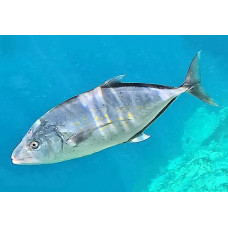Latin name
Carangoides bajad
Other name
Gold-spotted trevally
Identification
The body of the orange-spotted trevally is tall and strongly compressed at the sides. The upper profile of the body is more convex than the lower. The upper profile of the head is almost straight, with a slight rise at the occiput. The diameter of the eyes is smaller than the length of the snout. The tufted teeth are arranged in narrow bands on both jaws. The width of the bands is greater in the anterior part of the jaws. On the coxae, the teeth are arranged in a triangular spot without a central protrusion. The first gill arch has 25-33 gill stamens, of which there are 7-9 on the upper part and 18-21 on the lower part. The anterior part of the lateral line is arcuate, merging into a straight part at the level of the vertical, passing between 11 and 15 soft rays of the second dorsal fin. The chord of the curved part is longer than the straight part of the lateral line. Straight part of lateral line with 14-26 scales and 20-30 weak rays. Thorax completely covered with scales or with a narrow patch of bare skin in anterior lower part. Vertebrae: 10 dorsal and 14 caudal vertebrae.
Features of fish fins
The two dorsal fins are clearly separated. The first dorsal fin has 8 hard rays, while the second has 1 barbed ray and 24-26 soft rays. In front of the anal fin there are two separate barbels. The anal fin has 1 barb and 21-24 soft rays. The anterior part of the blade of the second dorsal fin is shorter than the length of the head. The caudal fin is forked.
Fish colouring
Upper body orange-spotted trevally coppery, sides pale to silvery white with numerous orange-yellow spots. The dark spot on the gill cover is absent. May change body colour to almost completely orange.
Distribution
Widespread throughout the Indo-Pacific region. Found in the Persian Gulf, Red Sea, Gulf of Aden, Gulf of Oman and further east into South East Asia. In the western Pacific they are found in the Gulf of Thailand, off Indonesia, the Philippines and Papua New Guinea to the Solomon Islands in the east and north to Japan.
Habitat
Marine pelagic fish. Inhabit coastal waters in areas of rocky and coral reefs.
Size
The maximum body length of Pacific fish is 55 cm, usually up to 42 cm. Other reports suggest they can reach 72 cm.
Behavior
Adults are often found on the slopes of coastal reefs or around large coral pinnacles in lagoons. The xanthic form, often seen in muddy bays, is found in schools. Juveniles are solitary in sheltered coastal bays.
Food and feeding habits
They feed on small fish and crustaceans.
Reproduction
Females mature when they reach 24.7 cm in length. They spawn from May to September with a peak from June to September.
Fishing
A commercially important species.
Relationship with a person
Harmless.
| Classification | |
| Phylum | Chordata |
| Class | Actinopterygii |
| Squad | Carangiformes |
| Family | Carangidae |
| Genus | Carangoides |
| Species | C. bajad |
| Features | |
| Conservation status | Least Concern |
| Habitat | Pelagic |
| Life span, years | No information |
| Maximum body weight, kg | No information |
| Maximum length, cm | 72 |
| Sailing speed, m/s | No information |
| Threat to people | Edible |
| Way of eating | Predator |
Orange-spotted trevally
Tags: orange spotted trevally



